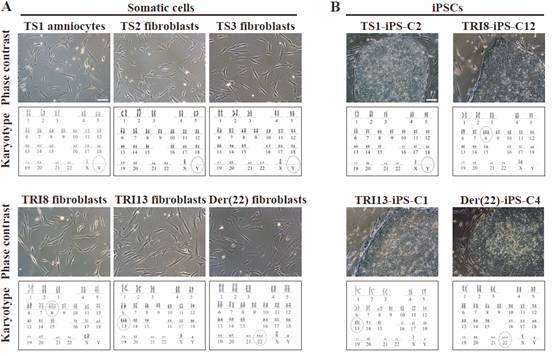Modeling Abnormal Early Development with Induced Pluripotent
Aneuploid syndromes are caused by supernumerary or reduced number of chromosomes. About 2/3 aneuploid syndromes embryos abort spontaneously at early stages of development. Newborn babies with aneuploid syndromes generally have serious physical disease and mental retardation resulting from abnormal organogenesis, and patients with severe symptoms will die in one year old. The pathogenesis of aneuploid syndromes is not well understood so far because the difficult access to the material, and slow research progress.
The groups of Dr.Duanqing Pei and Dr. Miguel A. Esteban at GIBH have generated iPSCs from monosomy X (Turner Syndrome), trisomy 8 (Warkany Syndrome 2), trisomy 13 (Patau Syndrome) and partial trisomy 11;22 (Emanuel Syndrome). These cell lines can stably maintain the karyotype of the donors, and behave like embryonic stem cells in all tested assays. It suggests that chromosome aneuploidy does not affect the occurrence and complete reprogramming of cells, and neither affect the cells' pluripotency self-renewal and differentiation capacity. These iPSCs generated by the groups provide stem cell materials for further research of other aneuploid blastocysts problems at early stages of embryoid body formation.
Turner Syndrome iPSCs were used for further studies. They found that Turner Syndrome iPSCs displayed lower levels of the pseudoautosomal placental gene CSF2RA than normal iPSCs during the embryoid body formation. This study reveals that a decrease of critical gene expression may lead to the underdevelopment of the Turner syndrome embryos placenta, and eventually cause abortion.
This work was published in Human Molecular Genetics on Jan.1st, 2012 (http://www.ncbi.nlm.nih.gov/pubmed/21949351).

Figure 1. Generation of iPSCs from aneuploid syndromes.
A, Phase contrast of donor cells and their abnormal karyotype. Scale bars indicate 100μm. B, Phase contrast and karyotype of the indicated iPSC clones. Scale bar is 100μm.(Image by Li, Wang & Fan et al.)
Attachment Download:
-
Contact
-
Reference
-
Related Article